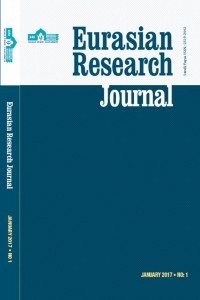THE ROLE OF CENTRAL BANK INDEPENDENCE IN PRICE STABILITY
THE ROLE OF CENTRAL BANK INDEPENDENCE IN PRICE STABILITY
This study aims to determine the relationship between inflation and the independence of central banks in post-Soviet, developed, and developing countries. The hypothesis of a negative statistical relationship between the inflation rate and the values of the CWN and GMT central bank independence indices and their constituent subindices for post-Soviet, developed, and developing countries for 2001–2020 was tested. Based on the results of the econometric assessment, the paper finds that high values of the central bank independence indices and their sub-indices help to keep inflation in a certain corridor: if inflation is high, central bank independence reduces it, and if inflation is low, it helps to keep inflation at a low level. The impact of central bank independence on inflation weakens as inflation decreases.
Keywords:
Central Bank Independence, Inflation, CWN and GMT Indices Post-Soviet Countries, Monetary Policy, Central Asia.,
___
- Baumann, Philipp, Rossi, Enzo, and Schomaker, Michael (2021). Central bank independence and inflation: Weak causality at best. Retrieved from: https://voxeu.org/article/central-bank-independence-and-inflation. Accessed: 05.03.2023.
- Berger, Helge, De Haan, Jakob, and Eijffinger, Sylvester (2001). Central Bank Independence: An Update of Theory and Evidence. Journal of Economic Surveys, 15(1): 3-40.
- Crowe, Christopher, and Meade, Ellen E. (2007). The Evolution of Central Bank Governance around the World. Journal of Economic Perspectives, 21(4): 69–90.
- Cukierman, Alex, Webb, Steven B., and Neyapti, Bilin (1992). Measuring the independence of central banks and its effect on policy outcomes. The World Bank Economic Review, 6(3): 353-398.
- Doyle, Christopher and Weale, Martin (1994). Do we really want an Independent Central Bank? Oxford Review of Economic Policy, 10(3): 61-77.
- Grilli, Vittorio, Masciandaro, Donato, and Tabellini, Guido (1991). Political and Monetary Institutions and Public Financial Policies in the Industrial Countries. Economic Policy, 13: 341–392.
- Haldane, Andy (2020). What Has Central Bank Independence Ever Done for Us? Retrieved from https://www.bankofengland.co.uk/-/media/boe/files/speech/2020/what-has-central-bank-independence-ever-done-for-us-speechby-andy-haldane.pdf. Accessed: 02.04.2023.
- Klomp, Jeroen, and De Haan, Jakob (2010). Inflation and Central Bank Independence: a Meta-Regression Analysis. Journal of Economic Surveys, 24(4): 593-621.
- Levenkov, Artem (2018). The Concept of Central Bank Independence: Theory and Practice. Bank Gazette, 18–25.
- Mas, Ignacio (1995). Central Bank Independence: A Critical View from a Developing Country Perspective. World Development, 23(10): 1639-1652.
- Moiseev, Sergey R. (2018). Central Bank Independence: Concept, Valuation Methods and the Impact of the Global Financial Crisis. Journal of the New Economic Association, 4(40): 110–136.
- Piga, Gustavo (2000). Dependent and Accountable: Evidence from the Modern Theory of Central Banking. Journal of Economic Surveys, 14(5): 563-595.
- Reis, Ricardo (2013). Central Bank Design. Journal of Economic Perspectives, 27(4): 17–44.
- Trunin, Pavel V., Knyazev, Dmitriy A., and Satdarov, Alexandr M. (2010). Independence of the Central Banks of the CIS and Eastern Europe. Institute for the Economy in Transition. Scientific works No. 133R, 1-76.
- UN (2021). World Economic Situation Prospects. Statistical Annex, pp. 125-126.
- World Bank (2022). World Development Indicators. Retrieved from https://databank.worldbank.org/ source/world-development-indicators. Accessed: 10.12.2022.
- ISSN: 2519-2442
- Yayın Aralığı: Yılda 4 Sayı
- Başlangıç: 2019
- Yayıncı: Hoca Ahmet Yesevi Uluslararası Türk-Kazak Üniversitesi
Sayıdaki Diğer Makaleler
EUROPEAN UNION’S SANCTION PACKAGES AGAINST RUSSIA: CONTENTS AND IMPLICATIONS
THE ROLE OF CENTRAL BANK INDEPENDENCE IN PRICE STABILITY
Bulat MUKHAMEDIYEV, Azimzhan KHITAKHUNOV, Zhansaya TEMERBULATOVA
EDUCATION POLICIES IN THE 21ST CENTURY COMPARATIVE PERSPECTIVES
THE INDISSOLUBILITY OF PHILOLOGY AND POETICS IN THE CREATION OF THE MEDIAEVAL EURASIAN KOINÊ
